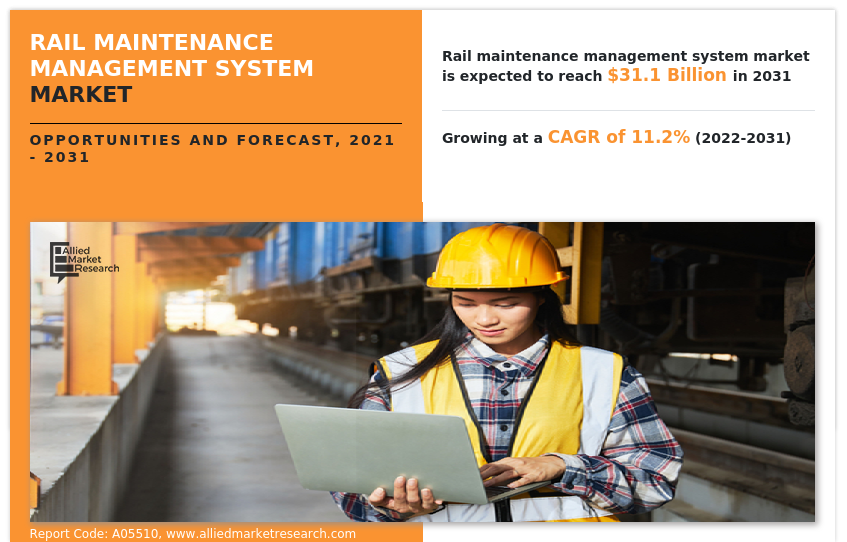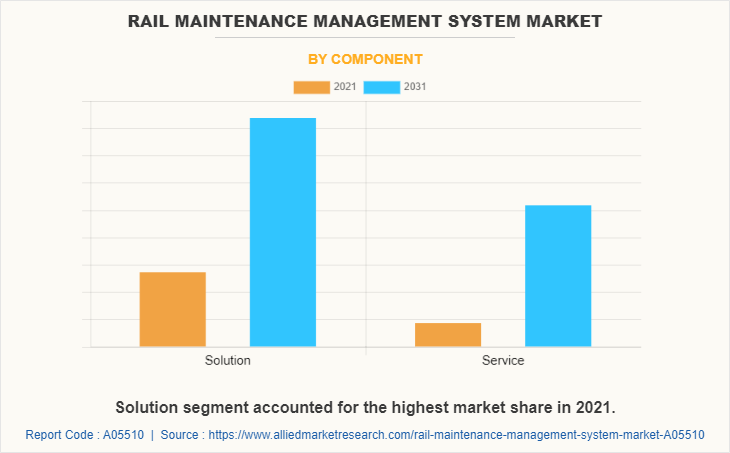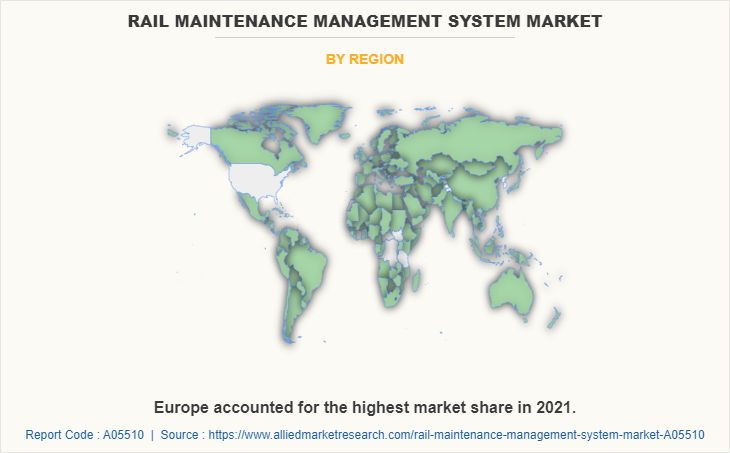Rail Maintenance Management System Market Research, 2031
The global rail maintenance management system market was valued at $11.1 billion in 2021, and is projected to reach $31.1 billion by 2031, growing at a CAGR of 11.2% from 2022 to 2031.
Growing trend of IoT and digitalization in rail transport, favorable government policies, and rising investments in expanding railway infrastructure boost growth of railway sector and provide new avenues for the rail maintenance management system market. Moreover, increase in rate in development of smart cities and smart railway projects fuel the market growth. However, high initial and maintenance cost of rail maintenance management systems along with data security and privacy issues related to IoT devices are some of the factors that hinder the market growth.
Moreover, surging adoption of cloud and Industry 4.0 technologies transforming the railway industry and untapped potential of emerging economies is expected to create lucrative growth opportunities for the market during the forecast period.

The rail maintenance management system is designed to specify a complete maintenance support system for the railways, allowing remote monitoring and diagnose complex systems of railway and subsequently produce adequate information to the final users. It is incorporated with varied manual and automatic systems that include a range of tools and services, which assists in quicker and better management of the rail industry. These systems have the potential to have a significant impact on all possible aspects related to the rail journeys from the train’s departure from the origin shed to its destination shed. Thus, it can proactively be used as real data and to resolve issues associated with operation and maintenance, asset management business process, regulatory compliance, and risk.
This results in ensuring, protecting, and improving passenger experience, thereby finding a wide range of applications in rail infrastructure. Further, changing technological trends and development have reduced the operation time and reduced the rate of errors during the functioning of railway. As a result, Rail Maintenance Management Systems are significant factors for business operations.
The report focuses on growth prospects, restraints, and trends of the rail maintenance management system market trends. The study provides Porter’s five forces analysis to understand the impact of various factors, such as bargaining power of suppliers, competitive intensity of competitors, threat of new entrants, threat of substitutes, and bargaining power of buyers on the rail maintenance management system market. The rail maintenance management system market is segmented into component, deployment mode and type.
Segment Review
The rail maintenance management system market is segmented on the basis of component, deployment mode, type, and region. By component, it is categorized into solution and services (consulting, system integration, and support & maintenance). By deployment mode, it is segmented into on-premise and cloud. By type, it is bifurcated into facility maintenance, rolling stock maintenance, track maintenance, signaling system maintenance, and others. Region-wise, the market is analyzed across North America, Europe, Asia-Pacific, and LAMEA region.
By component, the solution segment captured the largest market share in 2021, and is expected to continue this trend during the forecast period. This is attributed to several advantages provided by the solution such as secured operations and reduced risks, which has resulted in increase in the implementation of rail maintenance management system market. Further, the adoption of rail maintenance solutions helps simplify and organize the workflow and collaboration process, as well as increase maintenance efficiency to prevent rail operations failure are anticipated to fuel development of the solution segment across the globe.

Region-wise, the Asia-Pacific market is expected to grow at a significant rate in the future on account of increased proliferation of industry 4.0 and cloud technologies, particularly in countries such as China, Japan, and India. Moreover, increased focus of rail operators to upgrade or replace the ageing infrastructure and rolling stock coupled with growing demand for improving passenger experience & safety are further driving the adoption of rail maintenance management systems, which, in turn, drive the market growth across the region.

The report analyzes the profiles of key players operating in the rail maintenance management system market, such as Cisco Systems, Inc., IBM Corporation, ABB Group, Hitachi Rail Limited, Siemens Mobility GmbH, Toshiba Infrastructure Systems & Solutions Corporation, Trimble Inc., Alstom S.A., RailnovaSA, and Thales Group. These players have adopted various strategies to increase their market penetration and strengthen their position in the rail maintenance management system market forecast.
Top Impacting Factors
Rising trend of IoT and digitalization in rail transport demand for rail maintenance management system
Rising trend of IoT and digitalization in rail transport to improve optimization is directly influencing the growth of the global rail maintenance management system market. Radical advancements in the railway environment, enabled through communication technologies, require revising present business models and maintenance strategies. As a consequence, rail maintenance management systems are gaining significant adoption to increase the use of IT and control systems among railroad operators, particularly IoT and other digital technologies.
Increased use of IoT and digital solutions helps rail infrastructure managers to improve network availability, prolong asset lifetime, and empower technical staff to efficiently make maintenance. These factors are likely to contribute to the increased growth of rail maintenance management system market size, globally.
High initial and maintenance costs
Huge Capital Expenditure (CAPEX), along with increasing upfront installation costs is certainly restraining the adoption of rail maintenance management systems across the globe. Further, the integration of highly sophisticated technologies and components to provide efficient, reliable, and safe services. However, these sophisticated technologies and equipment are expensive, and the design, development, and implementation of digitalized systems involve high costs, which would be the major restraining factor for the growth of the global market.
In addition, these technically advanced systems entail a combination of electronic components and several subsystems to offer real-time data to the rail authority. It usually costs billions of dollars and more installation time compared to the conventional system, which leads to less preference among rail operators. These factors is expected to restrict the market growth during the forecast period.
Growth in adoption of cloud and Industry 4.0 technologies transforming the railway industry
Increasing adoption of cloud and Industry 4.0 technologies in the railway sector has proliferated the demand for rail maintenance management systems. It is the key to optimizing rail operational processes with the integration of advanced industry 4.0 technologies and cloud solutions. Leveraging the automation trends and use of smart data in rail maintenance management could lead to predictive maintenance and predictive quality.
In addition, the technical developments accelerate the digital transformation initiatives to recover lost time, reduce the cost of customer service, and de-risk traditional business models. Thus, the technological breakthrough in the development of railway infrastructure led to surge in demand for rail maintenance management systems to improve process optimization and passenger flows for real-time monitoring and control. These factors are expected to pave numerous opportunities for market growth during the forecast period.
COVID-19 Impact Analysis
The COVID-19 outbreak had a less negative impact on the rail maintenance management system industry. With the introduction of COVID-19, there were disruptions in the supply chain for rail infrastructure maintenance and limited operations of transportation in a bid to mitigate the impact of COVID-19 outbreak. However, the pandemic has caused a significant decline and suspension of planned rail maintenance by infrastructure managers in a few countries, such as Belgium, owing to the unavailability of subcontractors. These factors are expected to decline the market growth prospect in the short run.
Moreover, rail maintenance management system market is expected to gain traction in the long-run outlook, owing to continued surge in demand for maintenance management solutions, especially among railway authorities, in the wake of a pandemic. Following the COVID-19 outbreak, innovations and advancements in rail maintenance management system, such as real-time monitoring and AI technology have aided the market growth. Rise in digital transformation initiatives in rail infrastructure has considerably expanded the penetration of the rail maintenance management system market.
Key Benefits for Stakeholders
- This report provides a quantitative analysis of the market segments, current trends, estimations, and dynamics of the rail maintenance management system market analysis from 2021 to 2031 to identify the prevailing rail maintenance management system industry opportunities.
- The market research is offered along with information related to key drivers, restraints, and opportunities.
- Porter's five forces analysis highlights the potency of buyers and suppliers to enable stakeholders make profit-oriented business decisions and strengthen their supplier-buyer network.
- In-depth analysis of the rail maintenance management system market growth assists to determine the prevailing market opportunities.
- Major countries in each region are mapped according to their revenue contribution to the global market.
- Market player positioning facilitates benchmarking and provides a clear understanding of the present position of the market players.
- The report includes the analysis of the regional as well as global rail maintenance management system market share, key players, market segments, application areas, and market growth strategies.
Rail Maintenance Management System Market Report Highlights
| Aspects | Details |
| Market Size By 2031 | USD 31.1 billion |
| Growth Rate | CAGR of 11.2% |
| Forecast period | 2021 - 2031 |
| Report Pages | 276 |
| By Component |
|
| By Deployment Mode |
|
| By Type |
|
| By Region |
|
| Key Market Players | CISCO, IBM CORPORATION, ABB |
Analyst Review
Increase in the integration of IoT and digitalized solution in rail infrastructure allow early detection of asset degradation, prioritizing of asset maintenance tasks, and the ability to plan for inspection tasks contributes toward the rail maintenance management system market growth. Prominent players in the market have developed and launched new technologies, such as Cisco Systems, Inc., Alstom S.A., Siemens Mobility, and ABB Group to cater to a wide customer base across the globe.
The track maintenance segment has a predominant share in the rail maintenance management system market, and is expected to maintain this trend during the forecast period. However, demand for rail maintenance management system is expected to significantly increase across other applications, including rolling stock maintenance, facility maintenance, asset management, signaling system maintenance, ancillary software and maintenance, rail analytics, among others.
Moreover, increase in technological advancements, such as AI-enabled maintenance solutions and other supporting technical developments are expected to supplement growth of the rail maintenance management system market. Market players have adopted product launch, acquisition, and partnership strategies to improve their product portfolio and expand their geographical outreach. Emerging economies are expected to provide lucrative growth opportunities to market players in the future.
Major challenges for service providers are to integrate different technology elements, such as hardware, software, and network, which can be complex to configure. Without robust IT and skilled staff in rail infrastructure and maintenance, the implementation of rail maintenance management system is quite complicated. Further, these systems are not proficient enough to communicate with technologically advanced systems, which cause IT and network security restrictions. This challenge can be overcome by collecting data from accurate autonomous monitoring solutions has proliferated demand for rail maintenance management system, which is expected to boost the market growth during the forecast period.
Key players operating in the rail maintenance management system market include Cisco Systems, Inc., IBM Corporation, ABB Group, Hitachi Rail Limited, Siemens Mobility GmbH, Toshiba Infrastructure Systems & Solutions Corporation, Trimble Inc., Alstom S.A., RailnovaSA, and Thales Group. Key players have adopted various growth strategies to enhance and develop their product portfolio, strengthen their rail maintenance management system market share, and to increase their market penetration.
The rail maintenance management system market is estimated to grow at a CAGR of 11.2% from 2022 to 2031.
The rail maintenance management system market is projected to reach $12354.48 million by 2031.
Growing trend of IoT and digitalization in rail transport, favorable government policies, and rising investments in expanding railway infrastructure contribute toward the growth of the market.
The key players profiled in the report include Cisco Systems, Inc., IBM Corporation, ABB Group, Hitachi Rail Limited, Siemens Mobility GmbH, Toshiba Infrastructure Systems & Solutions Corporation, Trimble Inc., Alstom S.A., Railnova, and Thales Group.
The key growth strategies of rail maintenance management system market players include product portfolio expansion, mergers & acquisitions, agreements, geographical expansion, and collaborations.
Loading Table Of Content...


